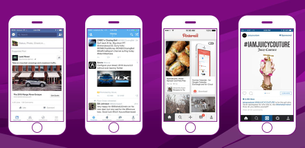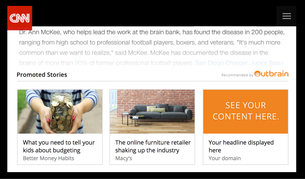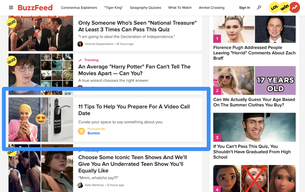Picture this: your flashy banner ads shine brightly, demanding attention from all who pass by, but what if that attention doesn't translate into engagement? Enter the art of native advertising. Native ads offer a refreshing approach that feels less like an interruption and more like a natural extension of the user's journey. By combining the impact of banner ads with the subtlety of native ads, you can craft a narrative that captivates your audience and drives meaningful interactions.
What Is Native Advertising?
Native advertising is a form of digital advertisement that elegantly blends into a website or mobile app’s natural flow of content. This type of advertising typically employs identifiers like “Suggested Posts” or “Sponsored Content” to distinguish itself from organic content while maintaining a seamless user experience. With its emphasis on content quality and seamless integration, native advertising offers a strategic advantage that complements traditional ads without detracting from their ability to capture attention.
Discover how these subtly integrated messages add value without intruding, marked by discreet labels that signify their paid nature without spoiling the fun.
Different Types of Native Ads
In-feed/In-content ads
In-feed native ads are strategically positioned within article and content feeds, such as news or social media feeds, ensuring they flow with the surrounding content. These ads mimic the platform’s design, layout, and tone and are often labeled as “sponsored” or “promoted” to maintain transparency about their commercial nature. In-feed native ads can feature a variety of formats, including static images, engaging videos, interactive elements, and compelling headlines. The goal is to capture the user’s attention without disrupting their engagement with the content stream.
On the other hand, in-content native ads are integrated directly within individual pieces of content, such as news articles, blog posts, or editorial features. These ads are strategically placed between paragraphs or after, ensuring they complement the narrative and flow of the page. In-content native ads match the visual and editorial style of the surrounding content, making them indistinguishable from organic content at first glance. They often include native storytelling, informative graphics, and relevant calls to action to encourage user engagement.
In-feed and in-content native ads are delivered programmatically, leveraging sophisticated algorithms and real-time bidding processes to optimize placement and targeting. Advertisers can tailor their native ad campaigns based on audience demographics, interests, behaviors, and contextual relevance. This level of customization ensures that native ads reach the right audience segments at the right time, maximizing engagement and conversion rates.

Captivate your audience effortlessly while blending seamlessly with the platform’s content for optimal engagement and conversion
Content recommendation ads
Content recommendation ads suggest relevant and engaging content to users based on browsing behavior, interests, and preferences. These ads usually appear as widgets or sections within a webpage, often labeled as “Recommended for you” or “You might also like.”
Unlike traditional ads that overtly promote products or services, content recommendation ads provide value by offering additional information or resources that align with the user’s interests. These ads also allow users to direct themselves to an external page or URL within the source publisher’s website, maintaining the flow of the user’s journey while ensuring transparency about the ad’s destination. This personalized approach enhances user engagement and encourages further exploration within the website or platform.

With content recommendation ads, tailored suggestions seamlessly blend with content, offering value and sparking curiosity.
Branded/native content
Branded native content, also known as brand content, sponsored content, or custom content, represents a strategic collaboration between brands and publishers to create paid content disguised into the publisher’s site. Marketers often leverage branded content to complement their owned content assets, providing audiences with fresh and engaging content experiences. The publisher typically develops this paid content in collaboration with the brand or by specialized content marketing agencies. It can be promoted through in-feed or content recommendation ads, enhancing its visibility and reach among the target audience.
The execution of branded content involves careful scheduling, tracking, and reporting, typically supported and facilitated by the publisher or the content marketing agency. This collaborative approach ensures that the content meets the brand’s objectives and the publisher’s standards, resonating effectively with the audience while maintaining authenticity.

This type of content offers a strategic blend of brand messaging and editorial integrity, delivering value, building trust, and engaging audiences authentically.
Advantages of Native Advertising
Creating native ads involves carefully curating various elements to ensure they resonate effectively with the target audience. Things like compelling images, attention-grabbing titles, and concise yet impactful descriptions ensure native ads capture attention and deliver valuable content that aligns with user interests and preferences. By combining these elements, native advertising offers a range of benefits, including:
Blending in vs. standing out
Native ads merge into the user experience, mimicking the look and feel of the platform they appear on. This approach avoids the disruptive nature of traditional ads, allowing native ads to blend in with editorial content and appear more organic.
More engagement
Because native ads fit naturally within the content environment, users perceive them as less intrusive. This non-disruptive nature encourages higher engagement levels, as users are more likely to interact with content that feels relevant and integrated rather than overtly promotional.
Access to high-value publishers
Native advertising provides access to premium publishers and their audiences, including well-known platforms like CNN, Forbes, and The New York Times. By appearing on contextually related pages, native ads can reach targeted audiences interested in specific topics or industries.
Scalable content deployment
Native advertising offers scalability, allowing marketers to deploy content and creative assets across multiple platforms with minimal modifications. This scalability enables marketers to reach a broader audience and optimize campaigns for different channels, maximizing their overall audience reach and impact.
Enhanced brand affinity and conversion
Native ads provide value and relevance to users, leading to enhanced brand affinity and trust. They generate higher brand recall and positive sentiment among audiences, increasing conversion rates and customer loyalty.
Pro Tip: Scale your campaigns and achieve superior results by tapping into AdRoll’s extensive inventory, spanning multiple native ad networks. Benefit from targeted and strategic ad placements to boost brand visibility, engagement, and overall campaign performance.
Native Advertising vs. Other Marketing Forms
Native advertising vs. display advertising
Native and display advertising represent distinct approaches to digital marketing, each with unique advantages and considerations.
Native ads offer several advantages over display or banner ads, particularly regarding user engagement. According to research, native ads outperform display ads significantly in terms of consumer attention and response. Statistics reveal that consumers engage with native ads 53% more frequently than display ads, indicating a strong preference for content that blends naturally with the platform’s editorial flow.
One key aspect differentiating native ads is their intentional design, which resembles organic content rather than traditional advertisements. Major social media platforms like X (formerly Twitter) and Facebook have embraced native advertising formats, recognizing their ability to enhance ad performance and user satisfaction. This strategic alignment with the platform’s natural environment contributes to native ads’ higher engagement rates than display ads.
However, compared to display ads, native ads may offer less control over ad design. Display ads, known for their visually striking nature and immediate impact, allow for more customized and attention-grabbing creatives. Yet, this visual appeal of display ads can sometimes result in a more intrusive advertising experience, potentially negatively affecting user engagement.
Native advertising vs. social media advertising
Native and social media advertising share similarities by camouflaging into the user experience and creating a cohesive online environment. In-feed social ads, such as sponsored posts on platforms like Facebook and Instagram, mirror native ads’ integration strategy. Both ads aim to provide users with a more natural and non-disruptive advertising experience.
However, the primary differences lie in their placement and campaign objectives. Social media advertising operates within a closed ecosystem, exclusively targeting users on specific social networks. In contrast, native ads have a broader reach, appearing on various websites and apps across the open web. Social advertising campaign goals often revolve around building brand followings within social networks, fostering engagement, and increasing visibility within a platform. On the other hand, native ads typically focus on directing potential customers to the advertiser’s website, engaging them with relevant content, and driving conversions based on user interests and behaviors.
Native advertising vs. contextual advertising
Contextual advertising revolves around targeting users based on the context of the content they are consuming. This approach involves analyzing the content of web pages, including keywords, topics, and themes to deliver relevant ads to users.
While native and contextual ads are distinct concepts, they can work synergistically to enhance the effectiveness of digital advertising campaigns. By combining the contextual relevance of ads with the native format’s assimilation, marketers can create highly targeted and engaging ad experiences.
For example, a contextual advertising campaign may identify users interested in outdoor activities based on their browsing content. Native advertising ensures that ads promoting outdoor gear or experiences present in a way that aligns with the platform’s aesthetics and user expectations.
Native advertising vs. content marketing
Content marketing is a long-term strategy focused on building a loyal following of readers who trust your brand. It emphasizes credibility and expertise through valuable, high-quality content. This approach requires meticulous planning and execution, leveraging content to improve search engine rankings and enhance organic online visibility.
The fundamental difference between content marketing and native advertising lies in ownership and distribution. Content marketing revolves around owned media platforms where the organization controls content creation, format, and distribution. It’s an inbound marketing strategy to build and engage an audience on the brand’s platforms.
In contrast, native advertising falls under paid media, leveraging existing audiences on third-party platforms. While the initial investment may be higher, native advertising offers immediate exposure to established audiences, saving time and resources. It’s a way to tap into existing reader bases and achieve quicker response rates than building an audience from scratch with content marketing.
5 Tips for Building Effective Native Advertising Campaigns
1. Ace native ad creative design
You’ll want to consider several key elements when designing your native advertising campaigns. First, avoid using company logos directly in the ad to maintain a seamless integration with the platform’s content. Second, pay close attention to image selection; choose visuals that draw attention and align with your ad’s message and the platform’s aesthetic. Finally, prioritize compelling copywriting that resonates with your target audience and complements your chosen imagery.
Pro Tip: Take advantage of our free ad creative service to nail your native advertising campaigns!
2. Target audiences across the customer journey
To maximize the effectiveness of your ads, target audiences strategically across the customer journey. Native ads offer various audience targeting options in digital advertising, such as demographic, interest-based, geographic, and lookalike targeting. Particularly effective is contextual targeting, as native ads seamlessly integrate with the surrounding content of publishers, enhancing relevance and engagement. Moreover, native advertising supports retargeting efforts, enabling advertisers to re-engage with interested audiences. By refining audience targeting through headline and image selection, native ads can cater to specific audience segments throughout the customer journey.
Pro Tip: With AdRoll’s advanced audience targeting tools, you can precisely target your audience throughout their customer journey, ensuring your native ads are seen by the right people at the right moments.
3. Invest in landing page content and user experience
Landing pages are the pivotal point where brands and audiences interact, making them integral to achieving campaign goals, whether generating interest in products or services or building brand awareness and trust. Advertisers must understand their target audiences’ varying interests and needs across different customer journey stages. Tailoring content and messages on landing pages to engage audiences effectively at each stage fosters meaningful interactions and enhances campaign performance.
Pro Tip: Ensure your landing page content and user experience align seamlessly with AdRoll’s guidelines to create engaging interactions that drive desired outcomes.
4. Create synergy with other advertising forms
While native ads effectively engage audiences, they shouldn’t be your only advertising tool. A well-rounded digital advertising strategy incorporates multiple ad formats and channels to reach customers at various touchpoints along their journey. This strategic approach ensures that marketing efforts align with the customer’s path from brand discovery to conversion. By combining the strengths of display, native, video, and paid search ads, you can create a cohesive and comprehensive campaign that optimizes reach, engagement, and conversion rates.
Pro Tip: Diversify your ad campaigns by leveraging AdRoll, where you can easily integrate various ad formats, such as display ads, social ads, and even email marketing.
5. Close the loop with marketing attribution
Since native ads may not always lead to immediate conversions, marketers rely on marketing attribution software to track and attribute conversions back to different touchpoints across the customer journey. This allows them to understand the impact of native ads in influencing customer behavior and contributing to overall campaign success. By leveraging marketing attribution, marketers gain valuable insights into which elements of their native advertising strategies drive conversions, and can therefore make data-driven decisions to optimize future campaigns.
Pro Tip: Utilize AdRoll’s cross-channel attribution capabilities to optimize budget allocation and understand the impact of each advertising form.
Native Advertising Trends
Native video ads
Native video ads are rapidly gaining traction within the advertising industry. While requiring more effort to create, these ads boast better engagement and capture more attention from audiences. The key to successful native video advertising is valuing web users’ attention and enhancing their experience, ultimately leading to improved ad recall. Brands are increasingly focusing on creating native video content that provides genuine value to users, be it through entertainment, information, or utility.
Dynamic native ads
Dynamic native ads combine the strengths of dynamic display ads with the seamless integration of native advertising. These ads typically feature one product image from your feed, a company name, a compelling title, and a concise description. They are particularly effective for retargeting campaigns, allowing brands to re-engage website visitors with personalized ads across various channels and devices. By leveraging visitor browsing activity, dynamic native ads can showcase top, recommended, or previously viewed products and services, enhancing relevance and driving higher engagement with target audiences.
Programmatic native advertising
Programmatic native advertising revolutionizes how ads are bought and sold by automating the process through real-time bidding. This method utilizes machine learning algorithms and contextual signals to customize native ads according to user behavior and placement context. As a result, programmatic native advertising ensures highly targeted and relevant ad placements at scale, leading to improved performance metrics for advertisers. This advanced technology streamlines the ad-buying process and optimizes ad delivery.
Unlocking Native Advertising Excellence with AdRoll
Native advertising has proven to be a powerful strategy for engaging audiences and effectively achieving marketing objectives. With AdRoll’s comprehensive suite of native advertising solutions, including dynamic native ads, programmatic native advertising, and more, you can explore various options to reach your target audiences with precision and impact. Discover the full potential of native advertising with AdRoll and elevate your marketing campaigns today.